This is completely off topic, but just way too beautiful for not reblogging [and somewhat more entertaining than the papal election]. In January this year—2013—↑Billy Joel was at Vanderbilt University, New York for ‘An evening of questions and answers and a little bit of music.’ So, naturally, a piano was on stage with Mr Joel. Michael Pollack, one of the students in the vast audience, got the chance to pose a question, and his chance he took. He asked Billy Joel if he would sing ‘New York state of mind’ with Michael accompanying him on the piano … the result you can watch above.
frankenrifle in mali

The above screencap from a BBC report on the conflict in Mali was made by @ByronDoerfer and sent to ↑C. J. Chivers, who gave a ↑first diagnosis:
This gentleman, reportedly a Chadian soldier in Mali, is holding what appears to be a well-worn ↑AKM variant with a host of after-market add-ons, creating a cosmetic hybrid between the globally established Kalashnikov operating system and the modern Western military obsession with rails, sights, tactical grips and collapsing stocks. [italics emphasis mine]
[…] I haven’t had time to review the kit of Chadian soldiers generally. So I can’t say whether this rifle is a one-off or now a standard in some Chad ground units. If the latter, and Chad’s arms-procurement officials have fitted out their AKs in such fashion, then some defense contractor or arms salesman somewhere may have made a fine penny. And if the latter, it would also be interesting to see a thoughtful analysis on whether such supposed upgrades have had any measurable effect on any units so equipped, or if money has been misspent.
This raises even more questions. First, no matter if it’s a one-off or a whole lot, why has it been assembled? Were there simply worn AKMs and parts of other rifles around? In other words: Is the hybrid the result of a chance seen within necessity? Or has it been designed deliberately? Following a set of æsthetics? If so, by whom are these æsthetics shared? By the manufacturers and the soldiers? Then, as Chivers hinted at, it’s completely unclear if the hybrid makes operational sense. Is it a good or a bad bricolage? Does it cater to operational needs, to æsthetic sense, to both, or none? The same question can be posed to ‘the modern Western military obsession with rails, sights, tactical grips and collapsing stocks.’ It’s quite probable that there are more hybrid weapon specimen around Africa and elsewhere—I’d like to see them and hear their stories.
damascus it is

On 26 February 2013 TV2 of Denmark needed a backdrop for a report on the current conflict in Syria. As it seems someone at the station searched the web for a suitable picture and hit upon a beautiful vista of the old city of Damascus. But the picture shows Damascus as it most probably has looked during the time of the ↑third crusade (1189-1192). Above that the picture doesn’t depict anything from the empirical world, but is a still from the computer game ‘↵Assassin’s Creed‘ (Ubisoft Montreal 2007). Quite tell-tale is the wooden beam attached to the minarett at the right. It’s a gameplay element from which you can perform the ‘↑leap of faith.’ Another gameplay element clearly visible are the rooftop gardens, those greenish cubes scattered atop buildings in the picture. Into this cubes, veiled by curtains, the character controlled by the player can ‘vanish’ after he has broken the line of sight between him and his persecutors.
But the irony goes even a step further. Most probably the people at TV2 hit upon the image via a Google image search, leading them to the subpage ‘↑Damascus‘ at the fan-driven ‘Assassin’s Creed’ wiki. The screencap wasn’t taken by a gamer, though. Rather it was made by Ubisoft staff and then given to the CGSociety for their 18 October 2007 feature ↑Assassin’s Creed: CGSociety production focus by Paul Hellard (the picture in question is to be found at the feature’s second page). The article is about the creation of the game’s environments, artistic blends of fantasy and historic realism …
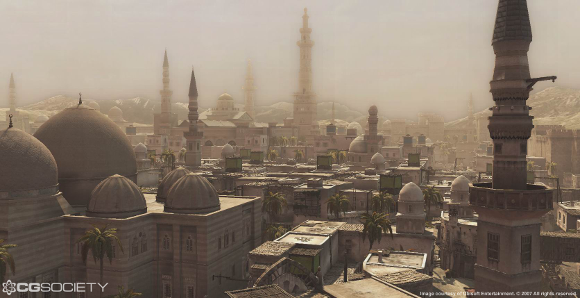
The whole thing of course was a slip by a staff member, and hence may not happen too often—although the BBC just recently made a ↑similar fault, also concerning Syria. Nevertheless I like to see said slip as a symptom, because several associations came to my mind.
Years ago I was invited to give a lecture on ‘Computer games and violence’ at the Bayreuth International Graduate School of African Studies (↑BIGSAS). The audience was composed mainly of doctoral students from diverse African universities. My talk’s focus was pretty much on competitive multiplayer first-person shooters, so I showed them pictures from e.g. ‘↑Quake III Arena‘ (Q3A; id Software 1999). The fantasy/horror/scifi environments of the Quake series hardly really resemble anything from our empirical world. Especially when the graphics are stripped of all detail by video settings usually employed in competitive playing. In consequence there was no recognition and my listeners could follow the topic emotionally detached. But then I showed pictures of one of the most popular ‘↑Counter-Strike‘ (CS; Valve Corporation 2000 [1999]) maps, and there was recognition:

This is a panorama view, made by ↑Zlandael, of the ‘↑Counter-Strike: Source‘ (CSS; Valve Corporation 2004) version of the map de_dust. A generic vista of a Near East, Northern, or Subsaharan Africa setting. The members of the audience at BIGSAS were perfectly aware that we were looking at an artificial topography following the ruleset of the game. What bothered them was the styling, resembling settings from their African countries of origin. Settings now used as an arena of violence, for a firearm battle between two teams labeled ‘terrorist’ and ‘counter-terrorist.’ Granted, there are CS and CSS maps which are e.g. Italian themed, and whatyouhave. Still, de_dust since years is one of the most popular maps, its looks well known outside of the CS community, almost having become synonym to CS. So, back to the question the audience back then asked me: Why is it that de_dust is styled like that? Well, I guess because by decades of news coverage pictures of ‘the’ Middle East have become inextricably linked with urban warfare and close quarter battle—within the minds of viewers from the North Atlantic societies. ‘Orientalism’ (Saïd 1978) redux.
Something similar is true for Africa at large. Following the TV news coverage you get the impression that Africa is a continent exclusively filled with corrupt governments, warlords, unstable, failed, and rogue states. An anarchic world of weapons and violence, the ideal setting for big adventure—like in ‘↑Far Cry 2‘ (FC2). Here is a screencap from the latter, depicting a Dogon village:
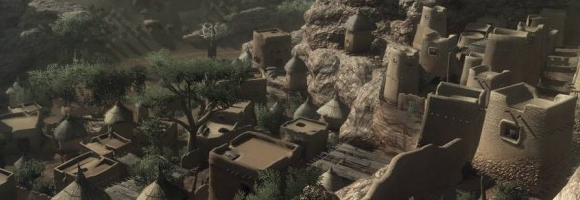
I wouldn’t be surprised when a screenshot like that from FC2 would creep up as a backdrop behind some anchorwoman delivering a report on Mali and the Dogon. There is a plethora of pictures of Dogon architecture online, especially because Dogon country is a major attraction for tourists visiting Mali. But in most of the cases the Dogon village screenshots from FC2 stand out. Just like the AC vista of ancient Damascus stood out for the staff member of Denmark’s TV2—little wonder, as it was created by top professional artists from the industry. Composition and lighting of the artificial pictures are not only superior, but follow Orientalist æsthetics.
All kinds of imaginary flow around the globe within the -scapes Appadurai (1996) proposed, recombine, influence, produce, and reproduce each other. It’s just like in a novel by Philip K. Dick—you never can be sure on which plane of reality you currently are.
technoscience leaving modernity?
The ideas and practices of Artificial Life research, and the interactions between these ideas and practices, are the topics of this thesis. How can the study of life, which ALife researchers see as pregiven by Darwinian evolution, be combined with the study of the artificial, which they see as “man made”? What implications do the combination of “artificial” and “life” have on how they practise their science? We will see that this combination makes Artificial Life a blend of a traditional naturalistic science and what they themselves sometimes call a postmodern science. (↑Risan 1997: ↑Introduction)
In their introduction Varela and Bourgine emphasise that Artificial Life is part of a longer line of thought. As many other ALife researchers do, they trace Artificial Life research back to the advent of ↑Cybernetics in the late 1940’s (1992:xi). Norbert Wiener defined Cybernetics as “control and communication in the animal and the machine.” (Wiener, 1948) Practitioners of cybernetics in the late 1940’s, as ALife researchers now, were occupied both with making life-like or intelligent computers and robots, and with understanding life and cognitive or mental phenomena. The emphasis that the ALifer in the story above placed on seeing cognition as embodied and embedded, that is, as an aspect of a larger system than the human brain, is something that he shares with many cyberneticians. Gregory Bateson, an anthropologist deeply involved in cybernetics, writes that “the mental characteristic of the system is immanent, not in some part, but in the system as a whole” (Bateson 1972:316). During the 1950’s the cybernetics movement fragmented. Some social scientists, with Bateson as a leading figure, started to apply the systemic perspective to social systems. This “social cybernetics” became particularly popular within family therapy (see for example Bateson et. al. 1956). Within engineering, cybernetics became a technique for making control systems (such as thermostats or goal seeking missiles). The discipline that combined the human/biological interest with the technical interest of the early cyberneticians became known as Artificial Intelligence (AI), today often referred to a bit ironically as GOFAI. The practitioners of this discipline distanced themselves from cybernetics. They rejected the holism of the systemic perspective and emphasised the formal and logical aspects of human cognition. The advent of Artificial Life research at places such as COGS is thus a reintroduction of the early cybernetical notions in contemporary artificial intelligence research.
ALife-researchers called themselves ALifers and, as a whole, the ALife community. The term “ALifer” was invented a bit as a joke at the first Santa Fe workshop in 1987. The term “ALife community” derives from the English designation of scientific communities (you also have the “anthropological community”). I first learned that Artificial Life existed from a book on the topic, written by the Danish biologist and philosopher of science, Claus Emmeche(2) (Emmeche 1991). (↑Risan 1997: ↑Introduction)(2) What interested me most was the re-discovery of cybernetic ideas and practices, the holism and the systemic thinking within established and/or main stream scientific institutions (as Cybernetics, with the advent of AI, had been expelled to quite marginal pockets of science).
hadfield and shatner
↑Chris Hadfield, currently on board of the ↑ISS (in mid-March he will take over command of the space station), having a chat with ↑William Shatner (on 07 February 2013).
where’s the original?
zeph’s pop culture quiz #58
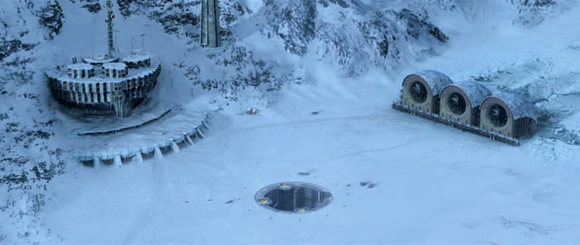
It will be a matter of seconds to identify the movie from which the above screencap stems. But, believe it or not, the building at the left was inspired by a real-life one. Where is the original building located?
Simply leave a comment with your educated guess—you can ask for additional hints, too. [Leaving a comment is easy; just click the ‘Leave a comment’ at the end of the post and fill in the form. If it’s the first time you post a comment, it will be held for moderation. But I am constantly checking, and once I’ve approved a comment, your next ones won’t be held, but published immediately by the system.]
fallingwater neuschwanstein hybrid
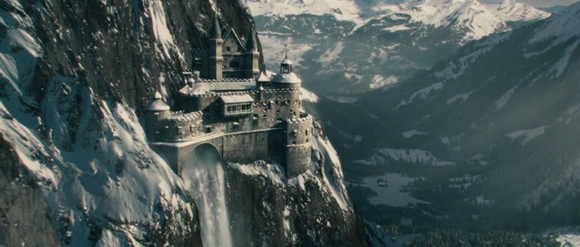
This is the fictional castle or fortress atop the ↑Reichenbach Falls where the showdown between ↑Holmes and ↑Moriarty takes place in ‘↑A Game of Shadows‘ (Ritchie 2011). It was ↑created by the VFX company Framestore. Their first inspiration was the ↑Festung Hohenwerfen in Austria:

But as Hohenwerfen looked a bit too military, the designers threw in elements inspired by ↑Schloss Neuschwanstein in Bavaria:

And then of course, the basic idea, to my eye, comes from ↑Frank Lloyd Wright‘s ↑Fallingwater:

xirdalium at wikipedia
No, not my humble blog here, rather the fictional element from which my humble blog here derives its name. It always bothered me, that Xirdalium—most likely an invention by Jules Verne’s son Michel—didn’t shine up in Wikipedia’s ↑list of fictional elements, materials, isotopes and atomic particles. Today I thought ‘enough is enough,’ or ‘there’s only so much a man can take,’ and created the following entry in said list:
Xirdalium. An element ‘a hundred times more radio-active than radium.’ (Verne 1909 [1908]: 125) Most probably it was invented by ↑Jules Verne‘s son ↑Michel, who introduced it to the novel ‘↑The Chase of the Golden Meteor,’ together with the character Zephyrin Xirdal, a ‘private genius’ who synthesized the new element. In the story Xirdal then uses Xirdalium in a contraption emitting a strong ↑tractor beam able to alter the trajectory of the meteor mentioned in the novel’s title.
This was overdue. Just had to be done.
UPDATE 1 (13 January 2013):
Seems like I have to update the Wikipedia entry. Something just didn’t seem right—a glance on the sidebar to the right would immediately have told me what it was. Here is the paragraph in question from the 1909 first edition of the novel by Verne fils et père:
“This, gentlemen.” he said, “is Xirdalium, a body a hundred times more radio-actice than radium. I am willing to own you that, if I utilize this body, it is more for show. Not that it is deleterious; but the earth radiates enough energy for me to do without adding more. It is a grain of salt thrown into the sea. Still, a little display is not unbecoming, methinks, in an experiment of this nature.” (Verne [& Verne] 1909: ↑125; bold emphasis mine)
And here is the complete paragraph from the 1908 French original:
«Ceci, Messieurs, disait-il, c’est du Xirdalium, corps cent mille fois plus radioactif que le radium. J’avouerai, entre nous, que, si j’utilise ce corps, c’est un peu pour la galerie. Ce n’est pas qu’il soit nuisible, mais la terre rayonne assez d’énergie pour qu’il soit superflu de lui en ajouter. C’est un grain de sel dans la mer. Toutefois, une légère mise en scène ne messied pas, à mon sens, dans une expérience de cette nature.» (Verne [& Verne] 1908: ↓chpt. 10; italics emphasis by Verne, bold emphasis mine)
As you can see the translator, Frederick Lawton, severely ↑nerfed the radioactivity of Xirdalium—by the factor thousand!
UPDATE 2 (13 January 2013):
All right, I rewrote the entry in the ↑list at Wikipedia and incorporated the two quotes above as footnotes. The entry now reads something like this:
Xirdalium. ↑The Chase of the Golden Meteor. An element which is, in the French first edition of the novel (Verne [& Verne] 1908), about a hundred thousand times more radioactive than radium. In the English first edition (Verne [& Verne] 1909) this has been reduced to a hundred times. Xirdalium was invented by ↑Jules Verne‘s son ↑Michel, who introduced it to the novel, together with the character Zephyrin Xirdal, a ‘private genius’ who synthesized the new element. In the story Xirdal then uses Xirdalium in a contraption emitting a strong tractor beam able to alter the trajectory of the meteor mentioned in the novel’s title.
The first sentence of the following quote I added as a third reference:
To Verne’s seventeen chapters Michel added four more. He created a dominant new character, Zephyrin Xirdal, who in effect takes over the action and the outcome. To succeed in this, Xirdal invents a “neuter-helicoidal current” and “atomic howitzers.” Gregory A. Benford, science professor at the University of California, Irvine, flatly calls these inventions “wholly imaginary physics.” Verne’s original La Chasse extrapolates only from the known and accepted science of his day. Michel violated one of his father’s basic principles in his “hard science” works: scientific integrity. (Walter & Miller 2006: xi)
And for the sake of it, here’s Verne-scholar Brian Taves:
In rewriting La Chasse au météore, Michel expanded his father’s novel from 17 chapters to 21 chapters, and made it more complex from a literary standpoint as well as enhancing the science fiction aspect. Michel adds a technological element to the novel, inserting a major new character, Zéphyrin Xirdal, an erratic scientist who has invented a device that attracts the comet to Earth, and brings it down from its orbit under his direction. Xirdal has selected Greenland for the landing, but becomes so disgusted by the global hysteria and his avaricious uncle’s attempt to manipulate the event for profit that he finally causes the meteor to fall into the sea. The financial markets return to the status quo, and Xirdal retreats to continue his own scientific work. Xirdal is a typical character in the Verne oeuvre, but his invention subtly shifts a major tenet of Verne’s writings. While his father’s forecasts were usually limited to what could be extrapolated from the known science of the day, Michel went considerably beyond these confining bounds of probability. This was true not only of Michel’s version of La Chasse au météore, but also of other science fiction stories he wrote and published under his father’s name, such as “Au XXIXe siècle: Journée d’un journaliste américain en 2889” (“In the 29th Century: The Diary of an American Journalist in 2889,” 1889), “Un Express de l’avenir” (“An Express of the Future,” 1893), “L’Eternel Adam” (“The Eternal Adam,” 1910), and The Astonishing Adventure of the Barsac Mission. (↓Taves 1999)
wireless devices 1906
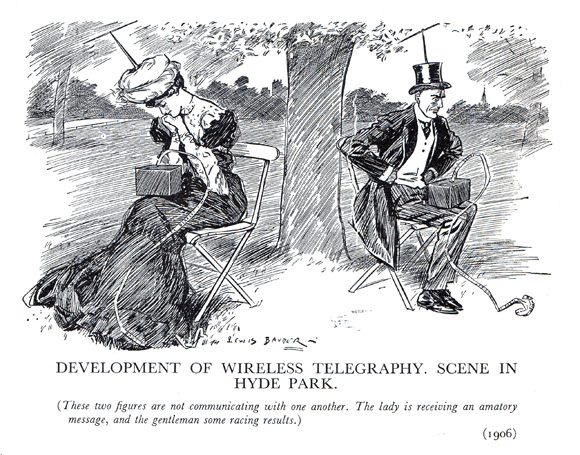
Kip W ↑unearthed the above wonderful, stunningly up-to-date ↑Punch cartoon (Williams 1955: 164) by artist ↑Lewis Baumer (1870-1963), which first was published in 1906! It’s great historical evidence for how early in the development of a given technology people not only speculate about the future trajectory of said development, but also think about possible social consequences of it.
weapons not concealed
The ↑Kroger gun stunt sparks 2nd Amendment debate, NBC reported yesterday:
Charlottesville police say the man who showed up at a Kroger grocery store with a loaded gun wanted to make a point. On Sunday, an unidentified 22-year-old man carried a loaded AR-15 into the Kroger store on Emmet Street and Hydraulic Road, sparking not only a scare for customers and employees but also a 2nd Amendment debate.
Charlottesville police drew their guns on the man after witnesses reported he brought a gun into the store. They restrained the man to ask him questions, but released him after they confirmed he is not a convicted felon, owned the gun legally and it was not concealed.
Police say he was cooperative and did nothing illegal. Officers did find a note in his pocket spelling out his intent to express his 2nd Amendment rights. […]
Now compare this to the following scene from Neal Stephenson’s ‘Cryptonomicon’ (1999):
In the lot of the 24 Jam, Mike or Mark has joined three other elvishlooking sorts in black cowboy hats and bandannas, whom Randy can identify based on the length and color of their ponytails and beards. There’s Stu, a Berkeley grad student who is somehow mixed up in Avi’s HEAP project, and Phil, who invented a major programming language a couple of years ago and goes helicopter-skiing in his spare time, and Craig, who knows everything there is to know about encrypted credit-card transactions on the Net and is a devotee of traditional Nipponese archery. Some of these guys are wearing long coats and some aren’t. There is a lot of Secret Admirers iconography: t-shirts bearing the number 56, which is a code for Yamamoto, or just pictures of Yamamoto himself, or big fat question marks. They are having an energetic and very happy conversation–though it looks a bit forced–because, to a man, they are carrying long weapons out in plain sight. One of them has a hunting rifle, and each of the others is slinging a rudimentary-looking gun with a banana clip sticking out of the side. Randy thinks, but is not sure, that these are HEAP guns.
This scene, not surprisingly, has caught the attention of the police, who have surrounded these four with squad cars, and who are standing at the ready with rifles and shotguns. It is an oddity of the law in many jurisdictions that, while carrying (say) a concealed one-shot .22 derringer requires a license, openly carrying (e.g.) a big game rifle is perfectly legal. Concealed weapons are outlawed or at least heavily regulated, and unconcealed ones are not. So a lot of Secret Admirers–who tend to be gun nuts–have taken to going around conspicuously armed as a way of pointing out the absurdity of those rules. Their point is this: who gives a shit about concealed weapons anyway, since they are only useful for defending oneself against assaults by petty criminals, which almost never happens? The real reason the Constitution provides for the right to bear arms is defending oneself against oppressive governments, and when it comes to that, your handgun is close to useless. So (according to these guys) if you are going to assert your right to keep and bear arms you should do it openly, by packing something really big. (Stephenson 1999: chpt. 76)

